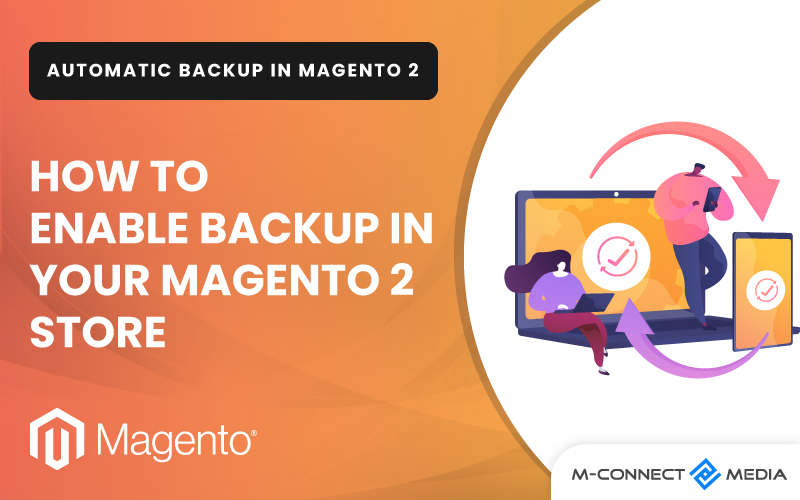Every Ecommerce business depends on its data, so losing it can be a big problem. That’s why it’s important to back up Magento 2 store to keep data safe. Magento 2, a well-known platform, which includes options that can assist you with automatic backup in Magento 2.
Data security is a top concern for eCommerce store operators. It’s more critical in systems like Magento, where users have to build everything from the ground up. So, the best way to protect against data loss is by regularly backing up data.
If you run Magento 2 store, you know how important data is. Creating backups is important for any online store. That’s because all the important stuff for a website is in the data. The whole point of a backup is to bring back the code and data for store.
If your data disappears, your Magento store goes with it. So, it’s super important to have a plan for making backups to ensure you never lose store. The good news is, making backups is pretty easy if you’re using Magento.
In this article, we’ll show you how to set up automatic backups in Magento 2, so you can stop worrying about your data and concentrate on growing your online business. So, let’s dive into How to Enable Automatic Backup in Magento 2.
Why Automatic Backup Necessary for Magento 2 Stores? Top Reasons
Automatic backups are crucial for your Magento 2 store for Several Important Reasons:
1. Protection Against Data Loss
In the fast-paced world of Ecommerce, Magento 2 business gathers large amounts of important data. This data includes customer orders, product details, inventory data, and more. Without regular backups, there’s a chance you could lose this vital information due to unexpected events like device failures, server crashes, or human mistakes.
Automatic backups ensure that all of this data is regularly saved and can be recovered if there are accidental deletions, data corruption, or other issues. It also adds an extra layer of security, ensuring that you can recover and restore company’s data in the worst-case scenario.
Also Read: How to Choose Best Magento 2 Theme for Your Store? A Detailed Guide
2. Security
Cybersecurity issues are a constant worry in the digital age. Malware attacks and data breaches pose a continuous threat to Magento 2 store. Online retailers always face the risk of cyber threats and attacks. To reduce these risks, automatic backups are generated.
Regular backups provide a safety net in case your store is targeted by malware or ransom ware. If your store is compromised, you can restore it to a safe state before the breach, reversing any harm caused by the attackers.
3. Regulations and Compliance
In the world of eCommerce, many industries and regions have strict rules about preserving and backing up data. Automatic backups help you stay compliant with these regulations.
Depending on where you operate business and the industry you’re in, data protection laws might require to maintain up-to-date backups. Automatic backups help you meet these requirements, keep out of trouble, and avoid any fines or penalties.
4. Minimize Downtime
Downtime can harm your eCommerce business. When your business faces unexpected technical issues that cause downtime, having up-to-date backups readily available can significantly reduce the time it takes to get your site back up and running.
Manual backups can be time-consuming, and if done during business hours, they can disrupt your operations. Automatic backups can be scheduled for low-traffic times to reduce disruptions and ensure your store is available when your customers need it.
In Summarize, automatic backups are essential parts of your Magento 2 store’s security and disaster recovery plan. They protect your data, keep business running smoothly, and provide peace of mind, allowing you to focus on growing and succeeding with online business.
How to Enable Automatic Backups in Magento 2 Store: Stepwise Guide
Magento 2 comes with a backup feature that allows you to easily back up different parts of your store. There are two ways to do this:
- Using Admin Panel in Magento
- Using Magento Command line interface (CLI)
Also Read: Magento 2 Coding: Best Practices You Should Consider and More Guide
Let’s see how to enable automatic backups in Your Magento 2 store through the Admin Panel.
Step 1: Navigate to Magento admin panel.
Log in to your Magento 2 admin panel using your username and password.
Step 2: Go to system configuration page.
Select “Stores” from left-side menu, and then choose “Configuration” from the “Settings” menu.
Step 3: Set up backup options
Click “System” in the left sidebar’s “Advanced” section. Expand the “Backup Settings” section on the right-hand side.
Step 4: Turn on Automatic backup.
Locate the “Scheduled Backup Settings” and switch it to “Enabled.” This will activate the automatic backup option in Magento 2.
Step 5: Configure backup frequency and start time.
Under “Scheduled Backup Settings,” you can adjust “Start Time.” Select time of day when you want automatic backup to begin. In Magento 2, you can schedule an automated backup by setting the time in hours, minutes, and seconds.
You can also choose the “Frequency” of backups. Magento 2 offers options like “Daily,” “Weekly,” and “Monthly.” Select the one that suits your needs best.
Step 6: Select backup providers
You can choose what data to include in automatic backups under “Backup Sources.” This is done by selecting “Database” and “Media.” You can add any specific data or files you need to back up, including the coding section of your store.
Also Read: Migrate From Magento 1 To Magento 2 Without Breaking Your Store
Step 7: Enable backup compression
Magento 2 allows you to compress backups to save disk space. In the “Compression Algorithm” field, you can choose between “None” or “Gzip” as the compression algorithm.
Step 8: Select Maintenance Mode
When this option is enabled, Magento 2 will enter maintenance mode while taking backups.
Step 9: Save the settings
After making these changes to your backup settings, save your configuration by clicking the “Save Configuration” button in the upper right corner.
Step 10: Check Automatic backup
To confirm that automatic backups are functioning correctly:
Go back to the “System” menu and select “Scheduled Backup Settings.” Here, you will find information about your scheduled backup, including the time it is set to run.
When you use Magento 2’s built-in backup system, it creates a.tgz compressed archive file for media backup files and a.sql file for the database. These backup files are stored in the var/backups directory until you decide to delete them manually.
Final Verdict
Backing up databases and information is crucial as it keeps system running smoothly and reduces the chances of errors and risks. Magento backup process through admin site is easy and takes a few clicks, whether you’re using Magento 1 or Magento 2.
Setting up automated backups in Magento 2 is an easy process that saves time and keeps online store safe from data loss. These steps will help ensure important data is securely backed up, giving you peace of mind and protection in case of an unexpected disaster.
Don’t wait too long set up automatic backups for online store today. You can enable automatic backup in Magento 2 using this method. I hope you found this blog post more informative and beneficial for your Magento 2 store. Feel free to share it with friends and stay connected with us for more updates.
For more about our Magento tutorials, blogs and News, check out our blog page.
Also Read: Benefits of Using Responsive Magento 2 Theme Design For Your Store
FAQs Related to Automatic Backup in Magento 2:
1.How to enable backup in Magento 2?
Alternatively, you may backup Magento 2 via the admin panel by going to System > Tools > Backups and selecting one of the three options listed below: Backup the system.
2. How do I enable Magento backup?
Enabling Automatic Backup in Magento 2:
- Access the Magento Admin Dashboard.
- Go to Stores > Configuration Settings.
- Expand the ADVANCED menu and choose System.
- Expand the Backup Settings section and check the Enable Backup box.
3. How do I automatically backup files?
Create a file backup from File History in Windows 10.
- Navigate to the Settings menu.
- Select Update & Security.
- Select Backup.
- Click the Add a drive button under the “Back up Using File History” column.
- Choose an external or detachable drive as the backup destination.
- Toggle the “Automatically backup my files” switch on.
4. How do I backup my Magento site?
To back up your Magento shop, head to System > Tools > Backups and select the backup type you want (System Backup, Database and Media Backup, or Database Backup). System Backup makes a backup of the database and file system.
ABOUT US
MAGENTO 2 DEVELOPMENT SERVICES
Since 2009, Mconnectmedia.com has provided Magento 2 development services. In the developing Ecommerce era, we are acknowledged as a reliable Magento development firm in the United States and India. You’ve come to the correct site if you’re seeking for the greatest business for your e-commerce store!
Are you wanting to build a new Magento website or improve an existing one? You’ve arrived to the right location! At Mconnect, We are a Magento 2 Development Agency that is certified. Our custom created Magento 2 extensions will assist you in scaling up your business more quickly.
Mconnect’s Magento 2 Developers extensively assess customers’ needs and target audience before creating a bespoke Magento shop that is user-friendly, responsive, conversion-optimized, and visually attractive.
Relevant Posts:
- Magento Development Agency or Magento Freelance Developer: Which Is the Better Option?
- LiteMage Cache For Magento 2 – Ultimate Installation Guide
- Reasons Why You Should Perform Magento 2 Migration Today

















